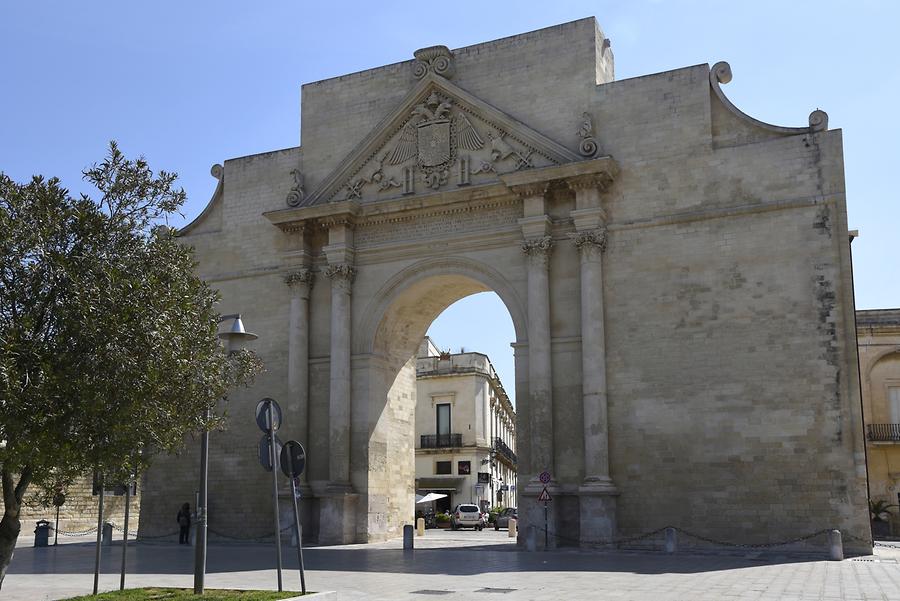Lecce - Porta Napoli#

Lecce - Porta Napoli, April 2017, © Gerhard Huber, under CC BY-NC 4.0 +Edu
Als festliches Barockensemble in honigfarbenem Tuffstein präsentiert sich die 95.000 Einwohner zählende Provinzhauptstadt Lecce
Lecce, Italy
. Ihre Blütezeit reicht bis in die Antike zurück. Kaiser Hadrian ließ die Via Appia bis hierher verlängern und errichtete ein Amphitheater für 20.000 Zuschauer. Keine 200 m weiter baute Augustus ein zweites Theater für 5000 Gäste. Später hinterließen viele illustre Völker ihre Spuren in der Stadt, die Byzantiner, die Langobarden, die Slawen, die Normannen und sogar die Venezianer. Doch die wahre Glanzzeit sollte erst noch kommen. Als Karl der V. im 16. Jahrhundert im gesamten Mittelmeerraum zum Kampf gegen Türken und Sarazenen rüstete, wurde Lecce zum strategisch wichtigen Ort. Der Zuzug von Aristokraten, Staatsdienern und Militärs bescherte der Stadt einen Aufschwung, der seine schönste Ausprägung im Lecceser Barock des 17. und 18. Jahrhunderts fand. Diese eigenständige Stilrichtung des Barock zeichnet sich durch besondere Üppigkeit und Verspieltheit aus. Kaum ein Zentimeter Mauer blieb ohne Schmuckwerk. Der weiche Tuffstein aus der Umgebung bildete dafür einen idealen Baustoff, der sich fast wie Holz schnitzen ließ und völlig neue Gestaltungsmöglichkeiten eröffnete. Unzählige Kirchen, Paläste, Klöster und Hospitäler verhalfen Lecce schnell zum Beinamen: 'das Florenz Süditaliens'.
The provincial capital of Lecce
Lecce, Italy
with its 95,000 inhabitants presents itself as a festive baroque ensemble in honey-colored tuff stone. Its bonanza period dates back to antiquity. Emperor Hadrian had the Via Appia lengthened as far as here and built an amphitheatre to seat 20,000 spectators. Less than 200 m further, Augustus built another theatre for 5000 guests. Over the years, many illustrious peoples left their mark on the city, the Byzantines, the Lombards, the Slavs, the Normans and even the Venetians. But the true heyday was yet to come. In the sixteenth century, when Charles V prepared to fight Turks and Saracens throughout the Mediterranean area, Lecce became a strategically important location. The influx of aristocrats, civil servants and military personnel brought the city an upswing which found its most beautiful expression in the Leccesian Baroque of the 17th and 18th centuries. This independent stylistic direction of the Baroque is characterized by a particular opulence and playfulness. Hardly an inch of a wall was left without decoration. The soft tuff from the vicinity was an ideal building material that could be carved almost like wood and opened up completely new scopes for design. Innumerable churches, palaces, monasteries and hospitals gave Lecce quickly its nickname 'Florence of southern Italy'.